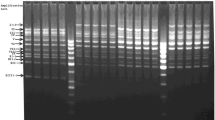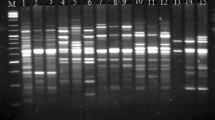Abstract
The detection of genotoxic effects using in vitro cell systems can be extremely useful in risk assessment procedures. However, care should be taken in the extrapolation of in vitro results since, amongst other factors, established cell lines may deviate from the genetic characteristics of their species. In this work, the genetic similarities between the RTG-2 cell line and rainbow trout individuals (Oncorhynchus mykiss) from several fish farms have been studied by the RAPD technique. Results show a significant analogy in the band patterns obtained for both systems, up to 73% of the bands composing the fingerprint of the RTG-2 cell line were found in all the individuals analysed. The inter-population similarity index (Lynch, 1990), considering the RTG-2 cell line as a population, gives a value of 0.931 between both systems. The dendrogram constructed from all the individuals, considering the RTG-2 cell line as just another individual of a single population, showed that the genetic structure of the cell line was not different from those of the other individuals tested. The strong genetic similarity of both systems, together with the previously proven capability of the RAPD technique to detect genetic alterations caused in vitro by genotoxic agents, can be very useful in genetic ecotoxicological studies.
Similar content being viewed by others
References
Al-Sabty K. (1991). Handbook of Genotoxic Effects and Fish Chromosomes). Ljubljana, Yugoslavia: J. Stefan Institute.
Al-Zahim, M., Newbury, H.J. and Ford-Lloyd, B.V. (1997). Classification of genetic variation in garlic Allium sativum L. revealed by RAPD. HortSciences 32, 1102-4.
Anderson, S., Sadinski, W., Shugart, L., Brussard, P., Depledge, M., Wirgin, I. and Wogan, G. (1994). Environ. Health Perspect. 102, 3-8.
Atienzar, F., Child, P., Avenden, A., Jha, A., Savva, D., Walker, C. and Depledge, M. (1998). Application of the arbitrarily primed polymerase chain reaction for the detection of DNA damage. Marine Environ. Res. 46, 331-5.
Atienzar, F., Conradi, M., Avenden, A., Jha, A. and Depledge, M. (1999). Qualitative assessment of genotoxicity using RAPD: comparison of genomic template stability with key fitness parameters in Daphnia magna exposed to benzo a pyrene. Environ. Toxicol. Chem. 18, 2275-82.
Atienzar, F., Cordi, B., Donkin, M.E., Evenden, A.J., Jha, A.N. and Depledge, M.H. (2000). Comparison of ultravioletinduced genotoxicity by random amplified polymorphic DNA with chlorophyll fluorescence and growth in a marine macroalgae Palmaria palmate. Aquat. Toxicol. 50, 1-12.
Bardakci, F. and Skibinski, D.O.F. (1994). Application of the RAPD technique in Tilapia fish, species and subspecies identification. Heredity 73, 117-23.
Bearmore, J.A., Dobzhansky, T.H. and Paulovsky, D. (1960). An attempt to measure the fitness of monomorphic and polymorphic populations of Drosophila pseudoobcura. Heredity 14, 49-55.
Becerril, C., Ferrero, M., Sanz, F. and Castano, A. (1999). Detection of mitomycin C-induced genetic damage in fish cells by use of RAPD. Mutagenesis 14, 449-56.
Bielawski, J.P. and Pumo, D.E. (1997). Ramdomly amplified polymorphic DNA RAPD analysis of Atlantic Coast striped bass. Heredity 78, 32-40.
Calleja, C. (1998). Establecimiento de relaciones filogeneticas mediante marcadores moleculares en las especies del genero Barbus en la peninsula Iberica. Tesis Doctoral. Univ. Compl. Fac. Madrid.
Conte, C., Mutti, I., Puglisi, P., Ferrarini, A., Regina, G., Maestri, E. and Marmiroli, N. (1998). DNA fingerprinting analysis by a PCR based method for monitoring the genotoxic effects of heavy metals pollution. Chemosfere 37, 2739-49.
Dinesh, K.R., Lim, T.M., Chua, K.L., Chan., W.K. and Phang P.E. (1993). RAPD analysis: an efficient method of DNA fingerprinting in fishes. Zool. Sci. 10, 849-54.
Ferrero, M., Castano, A., Gonzalez, A., Sanz, F. and Becerril, C. (1998). Characterization of RTG-2 fish cell line by random amplified polymorphic DNA. Ecotoxicol. Environ. Safety 40, 56-64.
Hadrys, H., Balick, M. and Schierwater, B. 1992. Applications of random amplified polymorphic DNA RAPD in molecular ecology. Mol. Ecol. 1, 55-63.
Hay, R., Marvin, M.C., Chen, T.R., McClintock, P. and Reid, Y. (eds.) (1988). Catalogue of Cell Line & Hybridomas, 6th Ed. Rockville, MD: ATCC.
Henry, R.J., Ko, H.L. and Weining, S. (1997). Identification of cereals using DNA-based technology. Cereal Food World 42, 26-29.
Koh, M.C., Lim, C.H., Chua, S.B., Chew, S.T. and Phang, S. (1998). Random amplified polymorphic DNA RAPD fingerprints for identification of red meat animal species. Meat Sci. 48, 275-85.
Krane, D.E., Sternberg, D.C. and Burton, G.A. (1998). Randomly amplified polymorphic DNA profile-based measures of genetic diversity in crayfish correlated with environmental impacts. Environ. Toxicol. Chem. 18, 504-8.
Kubota, Y., Shimada, A. and Shima, A. (1992). Detection of gamma ray induced DNA damages in malformed dominant lethal embryos of the Japanese medaka Orycias latipes using AP-PCR fingerprinting. Mutat. Res. 283, 263-70.
Kubota, Y., Shimada, A. and Shima, A. (1995). DNA alterations detected in the progeny of paternally irradiated Japonese medaka fish Orycias latipes. Proc. Natl. Acad. Sci. USA 92, 330-4.
Lynch, M. (1990). The similarity index and DNA fingerprinting. Mol. Biol. Evol. 7, 478-84.
Lynch, M. and Mulligan, B.G. (1994). Analysis of population genetic structure with RAPD markers. Mol. Ecol. 3, 91-9.
McCarthy, J.F. and Shugart, L.R. (1990). Biological markers of environmental contamination. In J.F. McCarthy (ed) Biomarkers of En¨ironmental Contamination, pp. 3-14. Boca Raton, FL: Lewis.
McDonald, J.K. and Ayala, F.J. (1974). Genetic response to environmental heterogeneity. Nature 250, 572-4.
OCDE. (1998). Addendum to OCDE Guidelines for Testing Chemicals 1998. France: OCDE.
Pritchard, M.K., Fournie, J.W. and Blazer, V.S. (1996). Hepatic neoplasms in wild common carp. J. Aquat. Animal Health 8, 111-9.
Rohlf, J. 1990. Numerical Taxonomy and Multivariate Analysis System. NTSYS-pc. New York: Dept. Ecol. Ecol.
Saitou, N. and Nei, M. (1987). The neighbor-joining method, a new method for reconstructing phylogenetic tree. Mol. Biol. Evol. 4, 406-25.
Savva, D. (1996). DNA fingerprinting as a biomarker assay in ecotoxicology. Tox. Ecotoxicol. News 3, 110-40.
Savva, D. (1998). Use of DNA fingerprinting to detect genotoxic effects. Ecotoxicol. Environ. Safety 41, 103-6.
Sheridan, A.K. (1995). The genetic impacts of human activities on wild fish populations. Rev. Fisheries Sci. 3(2), 91-108.
Sneath, T.H.A. and Sokal, R.R. (1973). Numerical Taxonomy. San Francisco: Freeman.
Sokal, R.R. and Michener, C.D. (1958). A statistical method for evaluating systematic relationship. Univ. Kansas Sci. Bull. 38, 1409-38.
Szalai, G., Toth, A., Lasztity, R. and Salgo, A. (1997). Techniques based on DNA determination in food quality control. Elelmiszer¨izsgalati-Koezlemenyek 43, 97-103.
Theodorakis, C.W. and Shugart, L.R. (1997). Genetic ecotoxicology II: population genetic structure in mosquitofish exposed in situ to radionuclides. Ecotoxicology 6, 335-54.
Theodorakis, C.W., Bickman, J.M., Elbi, T., Shugart, L.R. and Chesser, R.K. (1998). Genetics of radionuclidecontaminated mosquitofish populations and homology between Gambusia affinis and G. holbrooki. Environ. Toxicol. Chem. 17, 1992-8.
Walker, C.H. (1998). Biomarker strategies to evaluate the environmental effects of chemicals. Environ. Health Perspect. 106, 613-20.
Warren, A. J., Maccubbin, A.E. and Hamilton, W. (1998). Detection of mitomycin C-DNA adducts in vivo by 32 P-postlabeling: time course for formation and removal of adduct and biochemical modulation. Cancer Res. 58, 453-61.
Williams, J., Kuberlik, A., Livak, K., Rafalski, J. and Tingey, S. (1990). DNA polymorphisms amplified by arbitrary primers are useful as genetic markers. Nucleic Acids Res. 18, 56-78.
Wolf, K. and Quimby, M.C. (1969). Fish cell and tissue culture. In W.S. Hoar and Randall (eds), Fish Physiology, Vol. 3. New York: Academic Press.
Author information
Authors and Affiliations
Rights and permissions
About this article
Cite this article
Becerril, C., Acevedo, H., Ferrero, M. et al. DNA Fingerprint Comparison of Rainbow Trout and RTG-2 Cell Line Using Random Amplified Polymorphic DNA. Ecotoxicology 10, 115–124 (2001). https://doi.org/10.1023/A:1008902109692
Issue Date:
DOI: https://doi.org/10.1023/A:1008902109692




